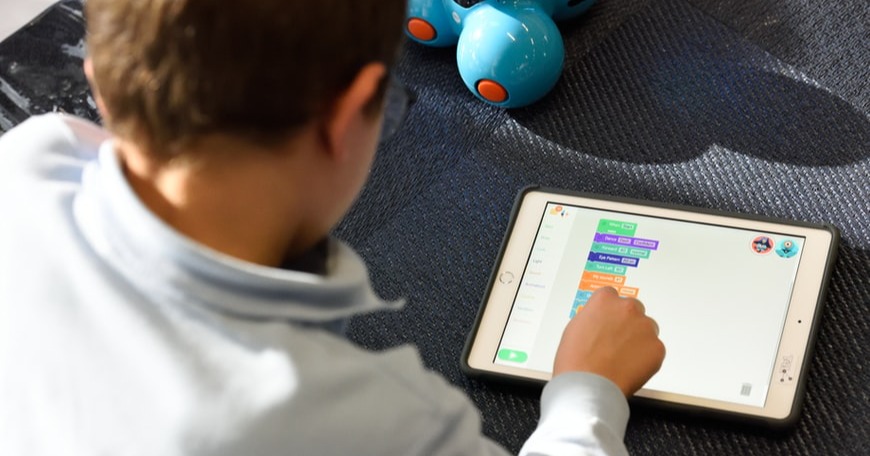The Impact of AI in Education: 4 Ways It Works
By and large, AI in education (AIEd) is a good thing, widely accepted by educators as an innovative way to aid their existing work and empower their students. By using artificial intelligence, institutions can enrich the learning experience through more autonomous ways of working — especially in blending learning landscapes.

We all recognise the ethical impact of artificial intelligence in that it could contribute to data privacy or isolation issues. However, the benefits of AI are thought to be worth the challenge of implementing it across schools, colleges and universities in the UK:
“The risks posed by AI in education are profound. But so too are the benefits that could be leveraged to tackle entrenched injustices faced by learners across the globe, and here in the UK.”
As a critical part of the fourth industrial revolution we’re now experiencing, artificial intelligence is helping us to offer more tailored, accessible education.
Yet, this doesn’t mean AI can do everything.
AI in education isn’t general AI as it isn’t equivalent to human intelligence. Instead, it’s an example of narrow AI that uses specific, intelligent systems designed to solve specific problems. From providing subject information to answering institutional questions, AI can help learners with their most obvious, pressing needs.
For this reason, investment in educational AI is growing. According to Jisc, in 2019, $3.67bn was invested in AI edtech start-ups, up from $2.89bn in 2018. Additionally, organisations such as the national AI centre are helping “unlock the power of artificial intelligence” and increase the ease of its uptake.
So, how exactly does AI impact education?
Providing a Parallel to In-Person Support
The changing educational landscape, accelerated by the pandemic, is uncovering a gap in educational communication and a need for more quickfire answers to be available at both learners’ and educators’ fingertips.
Digital assistants fulfil this need, supporting teachers and students by providing programmed information on timetables and policy. These AI-powered systems are education’s answer to the common eCommerce chatbot, providing a signposting service in schools, colleges and universities.
This type of AI is already being adopted by organisations, generating positive feedback from students. For example, a system called Ada has already been put in place at Bolton College with great success.
Digital support can also take different forms, helping other aspects of student life such as wellbeing. Cardiff and Vale College, for example, have implemented a wellbeing system with linguistic capability that has been co-created by students, for students. This type of AI technology guides personal development and nudges learners when they’re making good progress or when they need to focus on a specific area for improvement.
Either way, AI support is intelligent in recognising and regurgitating essential information, changing tone depending on its audience and responding to voice activation, such as other applications like Siri. Some systems of this kind may also feature recommendation engines — similar to those we see in search engines and on content websites — that can use algorithms to recommend further resources relevant to the user or query.
Aside from providing an additional layer of support, whether at home or inside an institutional building, these signposting systems improve engagement levels and benefit capacity, allowing educators to focus on the most impactful conversations with their learners.
Enabling Excellence During Distanced Learning
While AI information systems keep us connected throughout distanced learning, adaptive learning systems and subject-specific bots keep educational outcomes at a level of excellence.
In the short term, using AI to catch up after coronavirus has the greatest impact. Creating intelligent learning platforms with educator level information increases access to education, no matter where you’re learning and allows education to continue, largely without disruption.
The most popular way to implement this is via subject chatbots that support specific questions about a particular module, level of education or discipline. For example, a subject chatbot could offer comprehensive support on A-Level Maths Algebra.
Better yet, subject chatbots can take a crowdsourcing approach where any number of educators can contribute to its intelligence, giving a more unbiased, rounded learning experience than you could ever receive from a singular source.
In this sense, AI might not just enable excellence in distanced learning but better educational outcomes versus traditional teaching methods.
Users of such systems have remote access to an unthinkably broad knowledge base, as well as a more personalised learning experience where the difficulty changes depending on its data. For learners struggling with a certain topic, an adaptive learning system can identify when more support is needed and reinforce the learning, as well as identify other resources. All in all, this feeds into more individualised learning which creates a better overall learning experience.
From a teaching perspective, this way of working helps address the global shortage of teachers by sharing information on a mass scale and increasing educators' productivity as a whole.
Other developments in AI in this area could help create even more efficiencies, such as AI-assisted marking and feedback, showing educators an estimated grade for individual pieces of work.
Solving Accessibility Issues in Education
Although accessibility has become a major concern in distanced learning environments, it’s just the tip of the iceberg for learners around the globe.
Accessibility issues span much further than the temporary loss of entrance to education. Instead, educators and their institutions need to think more broadly of individuals who struggle to seek education due to their location, background or other personal factors.
In this vein, AI in education hopes to achieve something much more profound in helping everyone access the same level of education and teaching quality. By delivering personalised learning at scale, AI systems will help reach UNESCO’s fourth sustainable development goal: ensuring an inclusive and equitable education and promoting lifelong learning opportunities for all.
As a result, AI can help to increase social mobility and remove discrimination from education. After all, accessibility encompasses more than just economic divide but also learning styles. For example, conversational AI — where you can speak to a system and allow it to respond — helps all learner types, including those with learning disabilities to access information in a way that's easily comprehensible and evermore interactive.
AI, done in the right way, should empower students universally to acquire an education, in addition to or without in-person educator support. For example, AI features such as self-marking quizzes don’t require any interaction from educators, making it easier to check progress out of hours and better your understanding before formal assessments.
Uncover Other Educational Issues
A safe and considered introduction of AI in education helps solve many current problems in the educational system, both related to the learner and the educator. However, AI can also shed light on other issues we might not even be aware of yet.
As artificial intelligence systems work by collecting data and advance by using data to shape their next steps, they inevitably become a wealth of knowledge, holding historical information on how students learn, what they learn and when.
In collecting this information, we can identify important patterns and use learning analytics to predict future obstacles to create preemptive answers to issues that haven’t arisen yet but are likely to surface in the near future.
This long-term vision for AI truly shows the scope of its use in education, from being a temporary source of support in critical situations to becoming a staple tool for learners and educators around the world, as well as a way to drive innovation and find insights to create continual academic improvement.



.png)